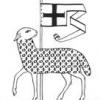void drawScene() {
glClear(GL_COLOR_BUFFER_BIT);
glMatrixMode(GL_MODELVIEW);
glLoadIdentity();
glEnable(GL_TEXTURE_2D);
glTexParameteri(GL_TEXTURE_2D, GL_TEXTURE_MIN_FILTER, GL_LINEAR);
glTexParameteri(GL_TEXTURE_2D, GL_TEXTURE_MAG_FILTER, GL_LINEAR);
for(float i=-5.0f;i<=3.0f;i+=2.0f)
{
//draw bricks
glBegin(GL_QUADS);
glTexCoord2f(-1.0f, 0.0f);
glVertex3f(i, 5.0f, 0.0f);
glTexCoord2f(-1.0f, 1.0f);
glVertex3f(i+2.0f, 5.0f, 0.0f);
glTexCoord2f(0.0f, 1.0f);
glVertex3f(i+2.0f, 4.5f, 0.0f);
glTexCoord2f(0.0f, 0.0f);
glVertex3f(i, 4.5f, 0.0f);
glEnd();
}
for(float i=-5.0f;i<=3.0f;i+=2.0f)
{
//draw bricks
glBegin(GL_QUADS);
glTexCoord2f(-1.0f, 0.0f);
glVertex3f(i, 4.5f, 0.0f);
glTexCoord2f(-1.0f, 1.0f);
glVertex3f(i+2.0f, 4.5f, 0.0f);
glTexCoord2f(0.0f, 1.0f);
glVertex3f(i+2.0f, 4.0f, 0.0f);
glTexCoord2f(0.0f, 0.0f);
glVertex3f(i, 4.0f, 0.0f);
glEnd();
}
for(float i=-5.0f;i<=3.0f;i+=2.0f)
{
//draw bricks
glBegin(GL_QUADS);
glTexCoord2f(-1.0f, 0.0f);
glVertex3f(i, 4.0f, 0.0f);
glTexCoord2f(-1.0f, 1.0f);
glVertex3f(i+2.0f, 4.0f, 0.0f);
glTexCoord2f(0.0f, 1.0f);
glVertex3f(i+2.0f, 3.5f, 0.0f);
glTexCoord2f(0.0f, 0.0f);
glVertex3f(i, 3.5f, 0.0f);
glEnd();
}
//draw paddle
glBegin(GL_QUADS);
glTexCoord2f(-1.0f, 0.0f);
glVertex3f(-1.0f, -4.5f, 0.0f);
glTexCoord2f(-1.0f, 1.0f);
glVertex3f(1.0f, -4.5f, 0.0f);
glTexCoord2f(0.0f, 1.0f);
glVertex3f(1.0f, -5.0f, 0.0f);
glTexCoord2f(0.0f, 0.0f);
glVertex3f(-1.0f, -5.0f, 0.0f);
glEnd();
glDisable(GL_TEXTURE_2D);
glutSwapBuffers();
}
void paddle_left()
{
glClear(GL_COLOR_BUFFER_BIT);
glEnable(GL_TEXTURE_2D);
glTexParameteri(GL_TEXTURE_2D, GL_TEXTURE_MIN_FILTER, GL_LINEAR);
glTexParameteri(GL_TEXTURE_2D, GL_TEXTURE_MAG_FILTER, GL_LINEAR);
//draw paddle
glBegin(GL_QUADS);
glTexCoord2f(-1.0f, 0.0f);
glVertex3f(-1.0f+i, -4.5f, 0.0f);
glTexCoord2f(-1.0f, 1.0f);
glVertex3f(1.0f+i, -4.5f, 0.0f);
glTexCoord2f(0.0f, 1.0f);
glVertex3f(1.0f+i, -5.0f, 0.0f);
glTexCoord2f(0.0f, 0.0f);
glVertex3f(-1.0+i, -5.0f, 0.0f);
glEnd();
i-=0.05f;
glDisable(GL_TEXTURE_2D);
glutSwapBuffers();
}
hopefully this is not too much.






